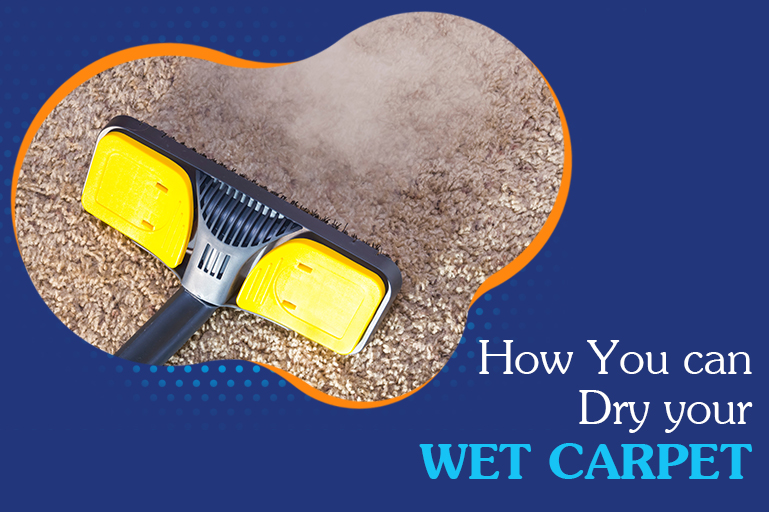Your fluffy carpet is certainly a matter of comfort. Though there can be some mishaps due to water, you should not postpone taking immediate action. The water which is left to linger may lead to the growth of mold and other problems from your carpet. Before taking any step, here is a quick evaluation of the situation to know what you should do next. Below are some factors that you need to take into consideration:
- How soaked or damp is your carpet
- Is the damp area restricted to a small area of your carpet or widespread all over the room?
- How much time has the carpet been damp?
- Where has water come from? A “clean” source like rain or a broken water line, or a “dirty” source like a flood or backed-up sewer line?
If there had been lots of water due to a flood or other accident, then you may call your homeowner’s insurance company and inquire about what should be covered. You can click photos of the damage when they ask for necessary documents.
Each situation has to be different, but here are some guidelines to consider:
- Try to act quickly– You should allow water to spread on the carpet even when it is slight. As mold grows quickly, the water may soak through and damage the subfloor as well as the pad.
- Do not forget about the pad– You need to lift carpets with padding which requires a long time to dry. It can produce a foul odor which may transfer easily to the carpet.
- Remain alert when using fans and dehumidifiers– You need to stay alert when using dehumidifiers, fans, and other electrical gadgets for drying the carpet. Try to keep the appliances away from water and see that the cords do not run through the damp areas.
Follow these tips for drying your wet carpet under various circumstances:
How to dry your damp carpet slightly
If a glass of water has fallen on the carpet or you had kept the window open during gentle rain then this water may have made your carpet wet. You can still dry the carpet as soon as possible and the process is really easy. For this, you have to run fun on the wet area and allow moisture to evaporate. Then, a dehumidifier may work to pull the moisture out of the air and dry your carpet. Another way is to put rags on the damp area and soak your carpet. You should protect heavy objects with waterproofing for avoiding further damage.
How to dry wet carpet soaking
Flooding or burst pipe is another source of getting clean water. But natural disaster or drain pipe is definitely a big problem. You are actually not handling the silt or sewage and you want to take an instant action to avoid the growth of odors and mold.
The professionals use water extraction machines that can remove water thoroughly from the carpet. But when there is not sufficient water, renting a wet-dry vacuum can solve the purpose. You may follow this do-it-yourself technique at home.
- Read through the instructions manual of the vacuum and ensure you have proper accessories and filters to vacuum up the liquids.
- After extracting the water, try to lift the carpet and remove the wet padding beneath.
- After this, you need to replace the soaked pad.
- Run through a dehumidifier in your room. If possible, keep the windows open for the spreading drying process. Running fans will create air currents which can help in drying. This method may require several days.
How to dry your carpet after a burst sewer pipe or flood
The water from a burst pipe is considered clean and water that soaks your carpet requires additional precautions. Gray water consists of pathogens and your carpet can get salvageable according to the source. But the professionals who help with water damage restoration can dry and decontaminate the carpets. You will possibly get the carpets dry but you cannot get rid of the contaminants by yourself. These professionals can treat your affected carpet by using special antimicrobial methods.
Blackwater is available from sources such as sewage pipes and full of bacteria and harmful pathogens. When there is a flood due to natural disasters, this may bring in bacteria silt, and other types of unwanted sludge. If you are facing such problems, then you need to dispose of and remove the carpet for your health protection.
Thus, you should take proper measures at the time of removing carpet and wear protective gear for disposing of contaminated carpet as well as padding. You may check with the garbage service about disposal and when you cannot place padding and carpet in the collection bin, your service may provide a pick-up option. Use search strings like, “carpet cleaners near me” for cleaning the carpet thoroughly from a professional in your area.
Hello, This is Harsh Shah Website and this is a bit off about him. He is a Best and Professional Author, Social Media and Content Marketing, The SEO Analysis of Marketing Profs. That`s enough for more details please so him at social media and contact him.
